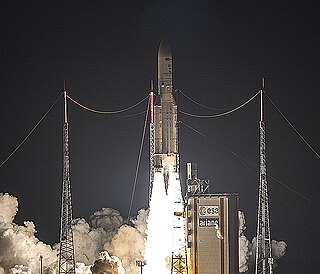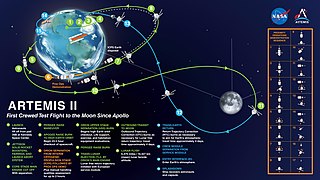
Koreasat is a series of South Korean communications satellites operated by KT SAT, a subsidiary of KT Corporation.

Koreasat is a series of South Korean communications satellites operated by KT SAT, a subsidiary of KT Corporation.
| Designation | Other name | COSPAR ID | SATCAT no. | Launch Date | Launch Vehicle | Launch Site | Orbit | Longitude | Status | Retirement | Remarks | Source |
|---|---|---|---|---|---|---|---|---|---|---|---|---|
| Koreasat 1 | Kt Corporation | 1995-041A | 23639 | 1995-08-05 | Delta II 7925 | Cape Canaveral | GSO | 116ºE | Operational | March 13, 2023 | ||
| Koreasat 2 | 1996-003A | 23768 | 1996-01-14 | Delta II | Cape Canaveral | GSO | 116ºE | Operational | [1] | |||
| Koreasat 3 | ABS-7 | 1999-046A | 25894 | 1999-09-04 | Ariane 42P | Kourou | GSO | 116.1ºE | Operational | [2] | ||
| Koreasat 4 | - | - | - | - | - | - | - | - | - | - | Unused because the number four is associated with death in Korea | |
| Koreasat 5 | ANASIS-I | 2006-034A | 29349 | 2006-08-22 | Zenit 3SL | Odyssey | GSO | 113ºE | Operational | |||
| Koreasat 5A | 2017-067A | 42984 | 2017-10-30 | Falcon 9 Full Thrust | Cape Canaveral | GSO | 113ºE | Operational | [3] | |||
| Koreasat 6 | 2010-070B | 37265 | 2010-12-29 | Ariane 5 | Kourou | GSO | 116ºE | Operational | [4] | |||
| Koreasat 7 | 2017-023A | 42691 | 2017-05-04 | Ariane 5 | Kourou | GSO | 116ºE | Operational | [5] | |||
| Koreasat 8 | ABS-2 | 2014-006A | 39508 | 2014-02-06 | Ariane 5 | Kourou | GSO | 75ºE | Operational | [6] [7] | ||
| Koreasat 116 | ANASIS-II | 2020-048A | 45920 | 2020-07-20 | Falcon 9 Block 5 | Cape Canaveral | GSO | 116ºE | Operational | [8] |

FalconSAT is the United States Air Force Academy's (USAFA) small satellite engineering program. Satellites are designed, built, tested, and operated by Academy cadets. The project is administered by the USAFA Space Systems Research Center under the direction of the Department of Astronautics. Most of the cadets who work on the project are pursuing a bachelor of science degree in astronautical engineering, although students from other disciplines join the project.

KT Corporation, formerly Korea Telecom, is a South Korean telecommunications company. KT is the second-largest wireless carrier in South Korea, with 16.493 million subscribers as of Q4 2017.

This article outlines notable events occurring in 2006 in spaceflight, including major launches and EVAs. 2006 saw Brazil, Iran, and Sweden all get a national into space for the first time.
The Space Test Program (STP) is the primary provider of spaceflight for the United States Department of Defense (DoD) space science and technology community. STP is managed by a group within the Advanced Systems and Development Directorate, a directorate of the Space and Missile Systems Center of the United States Space Force. STP provides spaceflight via the International Space Station (ISS), piggybacks, secondary payloads and dedicated launch services.
ChinaSat is the brand name of communications satellites operated by China Satellite Communications.

Boeing 702 is a communication satellite bus family designed and manufactured by the Boeing Satellite Development Center, and flown from the late-1990s into the 2020s. It covers satellites massing from 1,500 kg (3,300 lb) to 6,100 kg (13,400 lb) with power outputs from 3 to 18 kW and can carry up to approximately 100 high-power transponders.

This comparison of orbital launch systems lists the attributes of all individual rocket configurations designed to reach orbit. A first list contains rockets that are operational or in development as of 2023; a second list includes all upcoming rockets and a third list includes all retired rockets. For the simple list of all conventional launcher families, see: Comparison of orbital launchers families. For the list of predominantly solid-fueled orbital launch systems, see: Comparison of solid-fueled orbital launch systems.

Dream Satellite TV was the first all-digital Direct-To-Home (DTH) television broadcasting service via satellite in the Philippines. Broadcasting from the Dream Broadcast Center located at the Clark Special Economic Zone in Pampanga. Content is received from program providers, compressed and broadcast via Koreasat 5 in DVB-S and NTSC color format exclusively to its subscribers using the Integrated Receiver-Decoder and the Conax/Nagravision 3 Encryption System.

This article documents notable spaceflight events during the year 2019.

Notable spaceflight activities in 2017 included the maiden orbital flight of India's Geosynchronous Satellite Launch Vehicle Mark III on 5 June and the first suborbital test of Rocket Lab's Electron rocket, inaugurating the Mahia spaceport in New Zealand. The rocket is named for its innovative Rutherford engine which feeds propellants via battery-powered electric motors instead of the usual gas generator and turbopumps.

This article documents notable spaceflight events during the year 2018. For the first time since 1990, more than 100 orbital launches were performed globally.

A small-lift launch vehicle is a rocket orbital launch vehicle that is capable of lifting 2,000 kg (4,400 lb) or less or under 5,000 kilograms (11,000 lb) of payload into low Earth orbit (LEO). The next larger category consists of medium-lift launch vehicles.
The JSAT constellation is a communication and broadcasting satellite constellation formerly operated by JSAT Corporation and currently by SKY Perfect JSAT Group. It has become the most important commercial constellation in Japan, and fifth in the world. It has practically amalgamated all private satellite operators in Japan, with only B-SAT left as a local competitor.
Koreasat 1 was a South Korean communications satellite launched by a Delta II rocket from Cape Canaveral Air Force Station, Florida, United States. Owned by KT Corporation.
Koreasat 6 is a South Korean communications satellite operated by Koreasat. Koreasat 6 is the second satellite launched by operator KT Corporation which weighed about 2750 kg at the launching time. This satellite orbital position at 116 degrees East and provides broadcasting services and telecommunications throughout Korea.

Koreasat 7 is a South Korean communications satellite operated by KT SAT, a subsidiary of KT Corporation. Thales Alenia Space was contracted in 2014 to build both it and Koreasat 5A. Koreasat 7A was launched into geosynchronous orbit on 4 May 2017 aboard an Ariane 5 ECA launch vehicle and placed at 116 degrees east longitude to provide coverage over East Asia.

This article documents expected notable spaceflight events during the year 2025.

ANASIS-II, formerly called "KMilSatCom 1", is a South Korean military/government communications satellite which was launched on 20 July 2020. It was built by Airbus Defence and Space as part of an offset package into the purchase of 40 F-35 combat aircraft.